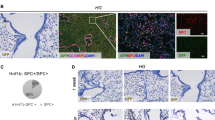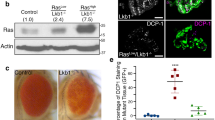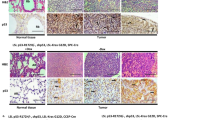Abstract
Although the ras genes have long been established as proto-oncogenes, the dominant role of activated ras in cell transformation has been questioned. Previous studies have shown frequent loss of the wildtype Kras2 allele in both mouse and human lung adenocarcinomas. To address the possible tumor suppressor role of wildtype Kras2 in lung tumorigenesis, we have carried out a lung tumor bioassay in heterozygous Kras2-deficient mice. Mice with a heterozygous Kras2 deficiency were highly susceptible to the chemical induction of lung tumors when compared to wildtype mice. Activating Kras2 mutations were detected in all chemically induced lung tumors obtained from both wildtype and heterozygous Kras2-deficient mice. Furthermore, wildtype Kras2 inhibited colony formation and tumor development by transformed NIH/3T3 cells and a mouse lung tumor cell line containing an activated Kras2 allele. Allelic loss of wildtype Kras2 was found in 67% to 100% of chemically induced mouse lung adenocarcinomas that harbor a mutant Kras2 allele. Finally, an inverse correlation between the level of wildtype Kras2 expression and extracellular signal–regulated kinase (ERK) activity was observed in these cells. These data strongly suggest that wildtype Kras2 has tumor suppressor activity and is frequently lost during lung tumor progression.
This is a preview of subscription content, access via your institution
Access options
Subscribe to this journal
Receive 12 print issues and online access
$209.00 per year
only $17.42 per issue
Buy this article
- Purchase on Springer Link
- Instant access to full article PDF
Prices may be subject to local taxes which are calculated during checkout







Similar content being viewed by others
References
Anderson, M., Reynolds, S., You, M. & Maronpot, R. Role of proto-oncogene activation in carcinogenesis. Environ. Health Perspect. 98, 12–24 (1992).
Barbacid, M. Ras genes. Annu. Rev. Biochem. 56, 779–827 (1987).
Marshall, C. How does p21ras transform cells? Trends Genet. 7, 91–95 (1991).
Hua, V., Wang, W. & Duesberg, P. Dominant transformation by mutated human ras genes in vitro requires more than 100 times higher expression than is observed in cancers. Proc. Natl Acad. Sci. USA 94, 9614–9619 (1997).
You, M., Candrian, U., Maronpot, R., Stoner, G. & Anderson, M. Activation of the K-ras protooncogenes in spontaneously occurring and chemically induced lung tumors of the strain a mouse. Proc. Natl Acad. Sci. USA 86, 3070–3074 (1989).
Guerrero, I., Calzada, P., Mayer, A. & Pellicer, A. A molecular approach to leukemogenesis: mouse lymphomas contain an activated c-ras oncogene. Proc. Natl. Acad. Sci. USA 81, 202–205 (1984).
Spandidos, D. & Wilkie, N. Malignant transformation of early passage rodent cells by a single mutated human oncogene. Nature 310, 469–473 (1984).
Sorrentino, V., McKinney, M., Drozdoff, V., Hume, C. & Fleissner, E. Spontaneous or carcinogen-mediated amplification of a mutated ras gene promotes neoplastic transformation. Oncogene Res. 2, 189–195 (1988).
Cohen, J. & Levinson, A. A point mutation in the last intron responsible for increased expression and transforming activity of the c-Ha-ras oncogene. Nature 334, 119–124 (1988).
Finney, R. & Bishop, M. Predisposition to neoplastic transformation caused by gene replacement of H-ras1. Science 260, 1524–1527 (1993).
Hegi, M.E. et al. Allelotype analysis of mouse lung carcinomas reveals frequent allelic losses on chromosome 4 and an association between allelic imbalances on chromosome 6 and K-ras activation. Cancer Res. 54, 6257–6264 (1994).
Bremner, R. & Balmain, A. Genetic changes in skin tumor progression: correlation between presence of a mutant ras gene and loss of heterozygosity on mouse chromosome 7. Cell 61, 407–417 (1990).
Buchmann, A., Ruggeri, B., Klein-Szanto, A.J. & Balmain, A. Progression of squamous carcinoma cells to spindle carcinomas of mouse skin is associated with an imbalance of H-ras alleles on chromosome 7. Cancer Res. 51, 4097–4101 (1991).
Stewart, S. & Guan, K.L. The dominant negative Ras mutant, N17Ras, can inhibit signaling independently of blocking Ras activation. J. Biol. Chem. 275, 8854–8862 (2000).
Shichinohe, T. et al. Suppression of pancreatic cancer by the dominant negative ras mutant, N116Y. J. Surg. Res. 66, 125–130 (1996).
Dammann, R. et al. Epigenetic inactivation of a RAS association domain family protein from the lung tumour suppressor locus 3p21.3. Nature Genet. 25, 315–319 (2000).
Johnson, L. et al. K-ras is an essential gene in the mouse with partial functional overlap with N-ras. Genes Dev. 11, 2468–2481 (1997).
Shimkin, M.B. & Stoner, G.D. Lung tumors in mice: application to carcinogenesis bioassay. Adv. Cancer Res. 21, 1–58 (1975).
McDoniels-Silvers, A.L., Herzog, C.R., Tyson, F.L., Malkinson, A.M. & You, M. Inactivation of both Rb and p53 pathways in mouse lung epithelial cell lines. Exp. Lung Res. 27, 297–318 (2001).
Manenti, G. et al. Linkage disequilibrium and physical mapping of Pas1 in mice. Genome Res. 9, 639–646 (1999).
Sills, R.C., Hong, H.L., Melnick, R.L., Boorman, G.A. & Devereux, T.R. High frequency of codon 61 K-ras A →T transversions in lung and Harderian gland neoplasms of B6C3F1 mice exposed to chloroprene (2-chloro-1,3-butadiene) for 2 years, and comparisons with the structurally related chemicals isoprene and 1,3-butadiene. Carcinogenesis 20, 657–662 (1999).
Lowry, D. & Willumsen, B. Function and regulation of Ras. Ann. Rev. Biochem. 62, 851–891 (1993).
McCormick, F. Activators and effectors of Ras p21 proteins. Curr. Opin. Genet. Dev. 4, 71–76 (1994).
Takeuchi, S. et al. Frequent loss of heterozygosity in region of the k1p1 locus in non–small cell lung cancer: evidence for a new tumor suppressor gene on the short arm of chromosome 12. Cancer Res. 56, 738–740 (1996).
De Gregorio, L. et al. Prognostic value of loss of heterozygosity and K-Ras mutations in lung adenocarcinoma. Int. J. Cancer 79, 269–272 (1998).
Cowley, S., Paterson, H., Kemp, P. & Marshall, C.J. Activation of MAP kinase is necessary and sufficient for PC12 differentiation and for transformation of NIH 3T3 cells. Cell 77, 841–852 (1994).
Borasio, G.D. et al. ras p21 protein promotes survival and fiber outgrowth of cultured embryonic neurons. Neuron 2, 1087–1096 (1989).
Borasio, G.D., Markus, A., Wittinghofer, A., Barde, Y.A. & Heumann, R. Involvement of ras p21 in neurotrophin-induced response of sensory, but not sympathetic neurons. J. Cell Biol. 121, 665–672 (1993).
Heumann, R. Neurotrophin signalling. Curr. Opin. Neurobiol. 4, 668–679 (1994).
Greene, L.A. & Tischler, A.S. Establishment of a noradrenergic clonal line of rat adrenal pheochromocytoma cells which respond to nerve growth factor. Proc. Natl Acad. Sci. USA 73, 2424–2428 (1976).
Noda, M. et al. Sarcoma viruses carrying ras oncogenes induce differentiation-associated properties in a neuronal cell line. Nature 318, 73–75 (1985).
Bar-Sagi, D. & Feramisco, J.R. Microinjection of the ras oncogene protein into PC12 cells induces morphological differentiation. Cell 42, 841–848 (1985).
Guerrero, I., Wong, H., Pellicer, A. & Burstein, D.E. Activated N-ras gene induces neuronal differentiation of PC12 rat pheochromocytoma cells. J. Cell Physiol. 129, 71–76 (1986).
Feig, L.A. & Cooper, G.M. Inhibition of NIH 3T3 cell proliferation by a mutant ras protein with preferential affinity for GDP. Mol. Cell Biol. 8, 3235–3243 (1988).
Chang, E.H., Furth, M.E., Scolnick, E.M., & Lowy, D.R. Tumorigenic transformation of mammalian cells induced by a normal human gene homologous to the oncogene of Harvey murine sarcoma virus. Nature 10, 479–483 (1982).
Pulciani, S., Santos, E., Long, L.K., Sorrention, V., & Barbacid, M. ras gene amplification and malignant transformation. Mol. Cell. Biol. 5, 2836–2841 (1985).
Cichutek, K. & Duesberg, P.H. Recombinant BALB and Harvey sarcoma viruses with normal proto-ras-coding regions transform embryo cells in culture and cause tumors in mice. J. Virol. 63, 1377–1383 (1989).
Corominas, M., Perucho, M., Newcomb, E. W. & Pellicer, A. Differential expression of the normal and mutated Kras alleles in chemically induced thymic lymphomas. Cancer Res. 51, 5129–5133 (1991).
Chen, B., Johanson, L., Wiest, J.S., Anderson, M.W. & You, M. The second intron of the K-ras gene contains regulatory elements associated with mouse lung tumor susceptibility. Proc. Natl Acad. Sci. USA 91, 1589–1593 (1994).
Schwab, M., Alitalo, K., Varmus, H.E., Bishop, J.M., & George, D.A cellular oncogene (c-Ki-ras) is amplified, overexpressed, and located within karyotypic abnormalities in mouse adrenocortical tumour cells. Nature 303, 497–501 (1983).
Heighway, J. & Hasleton, P. S. c-Ki-ras amplification in human lung cancer. Br. J. Cancer 53, 285–287 (1986).
Shiraishi, M., Noguchi, M., Shimosato, Y., & Sekiya, T. Amplification of protooncogenes in surgical specimens of human lung carcinomas. Cancer Res. 49, 6474–6479 (1989).
Slebos, R.J.C., Eyers, S.G., Wagenaar, S.S., & Rodenhuis, S. Cellular protoonocogenes are infrequently amplified in untreated non–small cell lung cancer. Br. J. Cancer 59, 76–80 (1989).
Field, J.K. & Spandidos, D.A. The role of ras and myc oncogenes in human solid tumours and their relevance in diagnosis and prognosis (review). Anticancer Res. 10, 1–22 (1990).
Brison, O. Gene amplification and tumor progression. Biochim. Biophys. Acta 1155, 25–41 (1993).
Esteller, M., Garcia, A., Martinez-Palones, J. M., Xercavins, J. & Reventos, J. The clinicopathological significance of K-ras point mutation and gene amplification in endometrial cancer. Eur. J. Cancer 33, 1572–1577 (1997).
Saranath, D. et al. Oncogene amplification in squamous cell carcinoma of the oral cavity. Jpn. J. Cancer Res. 80, 430–437 (1989).
George, D.L. et al. Structure and expression of amplified cKi-ras gene sequences in Y1 mouse adrenal tumor cells. EMBO J. 4, 1199–1203 (1985).
National Toxicology Program Toxicology and carcinogenesis studies of chloroprene (CAS no. 126-99-8) in F344/N rats and B6C3F1 mice (inhalation studies). NTP Technical Report 467, NIH Publication no. 96–3957, NIEHS, NIH, Research Triangle Park, North Carolina (1996).
Herrmann, C., Martin, G.A. & Wittinghofer, A. Quantitative analysis of the complex between p21ras and the Ras-binding domain of the human Raf-1 protein kinase. J Biol. Chem. 270, 2901–2905 (1995).
Acknowledgements
We are grateful to A. de la Chapelle, G. Leone, G. Stoner and H. Schut for their critical reading of this manuscript and helpful discussions. We thank A. Malkinson for LM2 cells and E. Wiley for secretarial assistance. Some of the work was performed at Medical College of Ohio (Toledo, Ohio). This work was supported by NIH grants R01CA58554 (M.Y.), R01CA78797 (Y.W.) and R01GM62694 (K.-L.-G.).
Author information
Authors and Affiliations
Corresponding authors
Supplementary information
Rights and permissions
About this article
Cite this article
Zhang, Z., Wang, Y., Vikis, H. et al. Wildtype Kras2 can inhibit lung carcinogenesis in mice. Nat Genet 29, 25–33 (2001). https://doi.org/10.1038/ng721
Received:
Accepted:
Published:
Issue Date:
DOI: https://doi.org/10.1038/ng721
This article is cited by
-
Critical requirement of SOS1 for tumor development and microenvironment modulation in KRASG12D-driven lung adenocarcinoma
Nature Communications (2023)
-
Enhanced BRAF engagement by NRAS mutants capable of promoting melanoma initiation
Nature Communications (2022)
-
Loss of the wild-type KRAS allele promotes pancreatic cancer progression through functional activation of YAP1
Oncogene (2021)
-
A structural model of a Ras–Raf signalosome
Nature Structural & Molecular Biology (2021)
-
Kras activation in endometrial organoids drives cellular transformation and epithelial-mesenchymal transition
Oncogenesis (2021)



